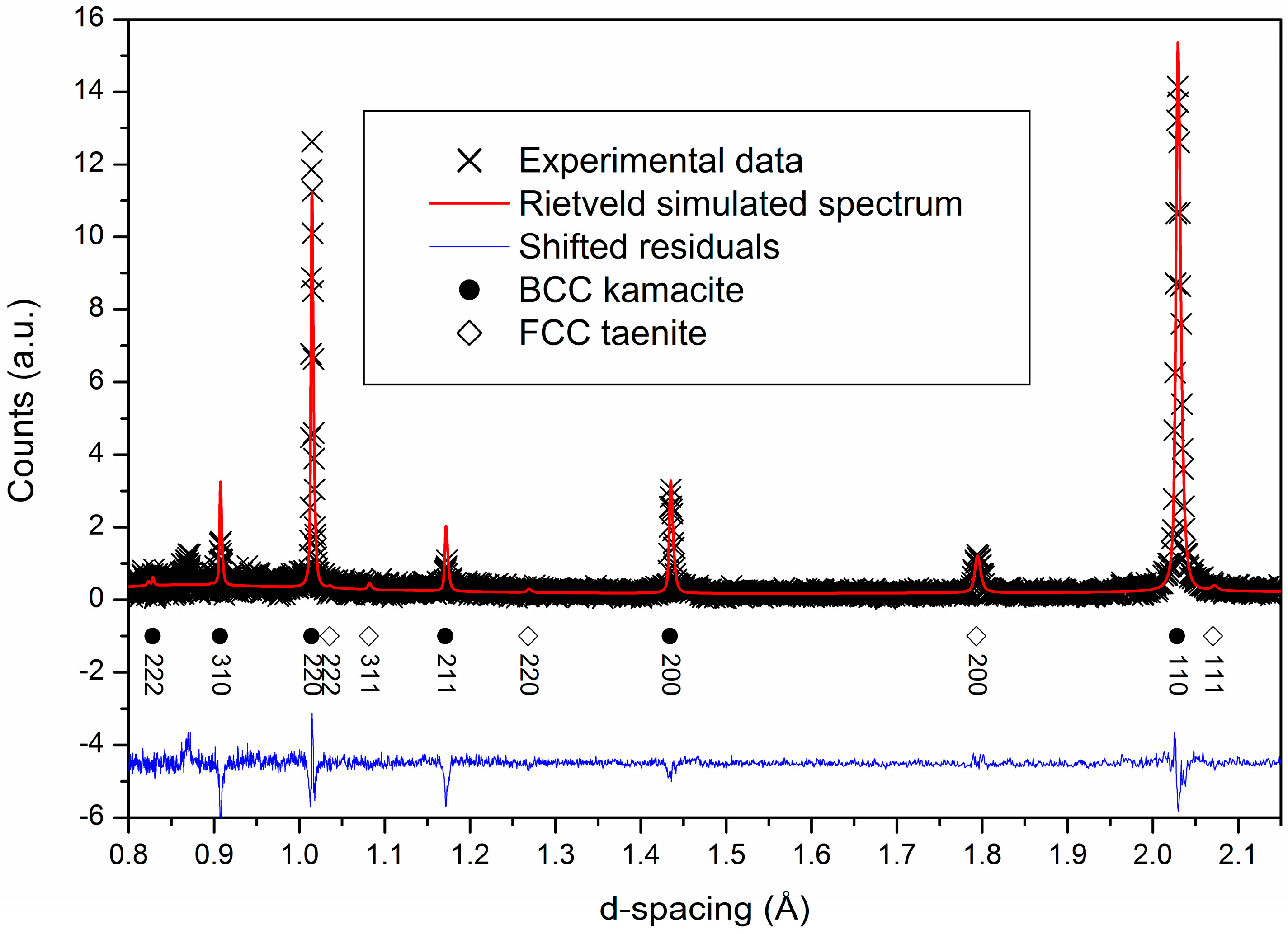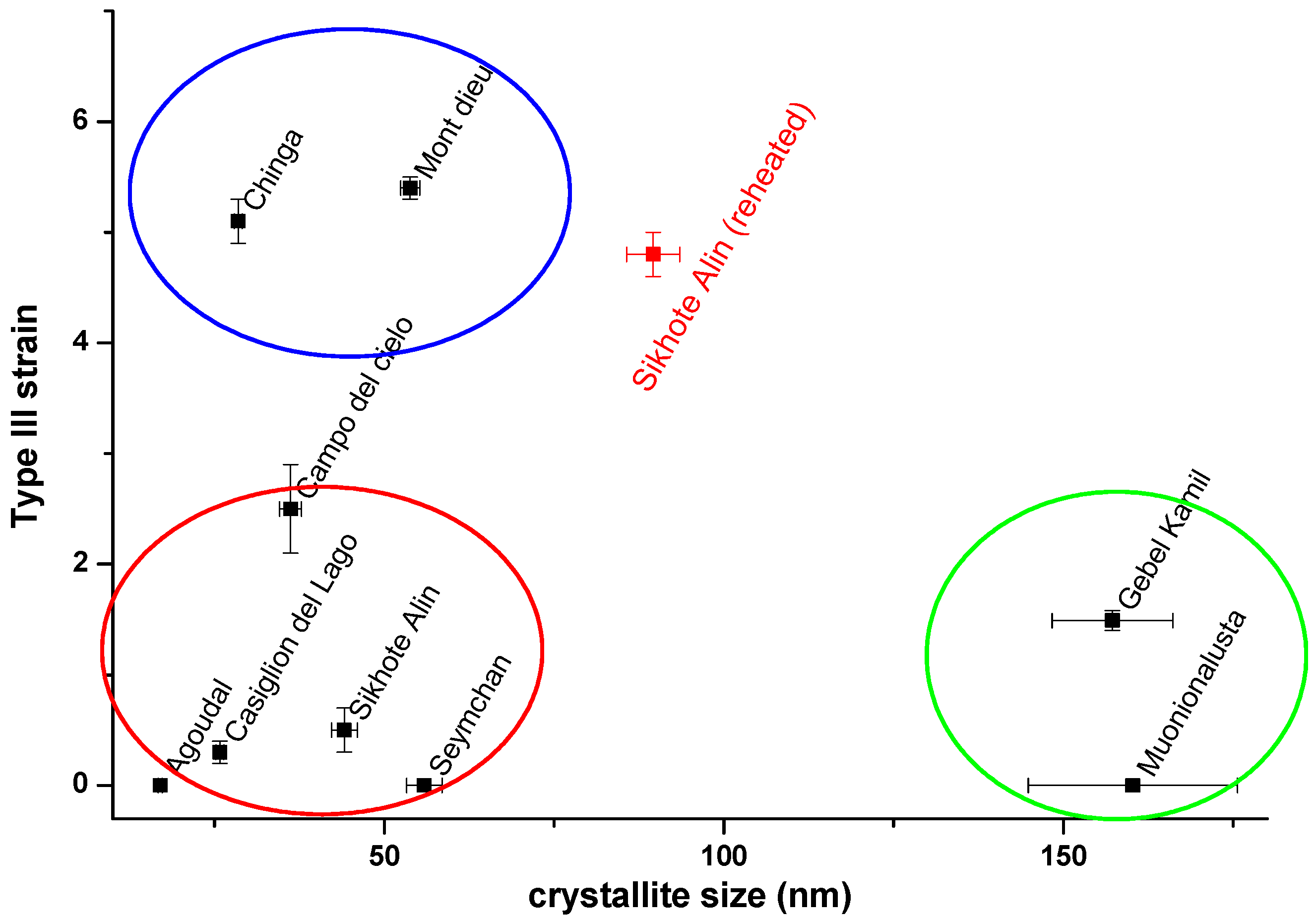Different Conditions of Formation Experienced by Iron Meteorites as Suggested by Neutron Diffraction Investigation
Abstract
:1. Introduction
2. Materials and Methods
3. Results
4. Conclusions
Acknowledgments
Author Contributions
Conflicts of Interest
Abbreviations
| BCC | body centered cubic |
| FCC | face centered cubic |
References
- Kokubo, E.; Ida, S. Formation of Protoplanets from Planetesimals in the Solar Nebula. Icarus 2000, 143, 15–27. [Google Scholar] [CrossRef]
- Goldstein, J.I.; Scott, E.R.D.; Chabot, N.L. Iron meteorites: Crystallization, thermal history, parent bodies, and origin. Chem. Erde-Geochem. 2009, 69, 293–325. [Google Scholar] [CrossRef]
- Hopfe, W.D.; Goldstein, J.I. The metallographic cooling rate method revised: Application to iron meteorites and mesosiderites. Meteorit. Planet. Sci. 2001, 36, 135–154. [Google Scholar] [CrossRef]
- Arletti, R.; Cartechini, L.; Rinaldi, R.; Giovannini, S.; Kockelmann, W.; Cardarelli, A. Texture analysis of bronze age axes by neutron diffraction. Appl. Phys. A Mater. Sci. Process. 2008, 90, 9–14. [Google Scholar] [CrossRef]
- Siano, S.; Kockelmann, W.; Bafile, U.; Celli, M.; Iozzo, M.; Miccio, M.; Moze, O.; Pini, R.; Salimbeni, R.; Zoppi, M. Quantitative multiphase analysis of archaeological bronzes by neutron diffraction. Appl. Phys. A Mater. Sci. Process. 2002, 74, 1139–1142. [Google Scholar] [CrossRef]
- Festa, G.; Caroppi, P.A.; Filabozzi, A.; Andreani, C.; Arancio, M.L.; Triolo, R.; Lo Celso, F.; Benfante, V.; Imberti, S. Composition and corrosion phases of Etruscan Bronzes from Villanovan Age. Meas. Sci. Technol. 2008, 19, 34004. [Google Scholar] [CrossRef]
- Höfler, S.; Will, G.; Hamm, H.-M. Neutron diffraction pole figure measurements on iron meteorites. Earth Planet. Sci. Lett. 1988, 90, 1–10. [Google Scholar] [CrossRef]
- Peetermans, S.; Grazzi, F.; Salvemini, F.; Lehmann, E.H.H.; Caporali, S.; Pratesi, G. Energy-selective neutron imaging for morphological and phase analysis of iron-nickel meteorites. Analyst 2013, 138, 5303–5308. [Google Scholar] [CrossRef] [PubMed]
- Caporali, S.; Grazzi, F.; Salvemini, F.; Garbe, U.; Peetermans, S.; Pratesi, G. Structural characterization of iron meteorites through neutron tomography. Minerals 2016, 6, 14. [Google Scholar] [CrossRef]
- Weiss, W.; Bunge, H.J. Diffraction contrast in X-ray radiographic images of octahedrite meteorites. J. Appl. Crystallogr. 2001, 34, 566–572. [Google Scholar] [CrossRef]
- Kotsugi, M.; Wakita, T.; Taniuchi, T.; Maruyama, H.; Mitsumata, C.; Ono, K.; Suzuki, M.; Kawamura, N.; Ishimatsu, N.; Oshima, M.; et al. Direct metallographic analysis of an iron meteorite using hard X-ray photoelectron emission microscopy. IBM J. Res. Dev. 2011, 55, 13:1–13:5. [Google Scholar] [CrossRef]
- Bunge, H.J.; Weiss, W.; Klein, H.; Wcislak, L.; Garbe, U.; Schneider, J.R. Orientation relationship of widmannstätten plates in an iron meteorite measured with high-energy synchrotron radiation. J. Appl. Crystallogr. 2003, 36, 137–140. [Google Scholar] [CrossRef]
- Grady, M.; Pratesi, G.; Moggi Cecchi, V. Atlas of Meteorites; Cambridge University Press: Cambridge, UK, 2014. [Google Scholar]
- Yang, J.; Goldstein, J.I.; Scott, E.R.D. Iron meteorite evidence for early formation and catastrophic disruption of protoplanets. Nature 2007, 446, 888–891. [Google Scholar] [CrossRef] [PubMed]
- Desrousseaux, A.; Doukhan, J.C.; Leroux, H.; Van Duysen, J.C. An analytical electron microscope investigation of some pallasites. Phys. Earth Planet. Inter. 1997, 103, 101–115. [Google Scholar] [CrossRef]
- Grazzi, F.; Celli, M.; Siano, S.; Zoppi, M. Preliminary results of the Italian neutron experimental station INES at ISIS: Archaeometric applications. Nuovo Cim. Della Soc. Ital. Fis. C 2007, 30, 59–65. [Google Scholar] [CrossRef]
- Imberti, S.; Kockelmann, W.; Celli, M.; Grazzi, F.; Zoppi, M.; Botti, A.; Sodo, A.; Leo Imperiale, M.; de Vries-Melein, M.; Visser, D.; et al. Neutron diffractometer INES for quantitative phase analysis of archaeological objects. Meas. Sci. Technol. 2008, 19, 34003. [Google Scholar] [CrossRef]
- ISIS. Available online: www.isis.stfc.ac.uk (accessed on 1 January 2017).
- Mantid. Available online: http://www.mantidproject.org/ (accessed on 10 August 2017).
- Larson, A.C.; Von Dreele, R.B. General Structure Analysis System (GSAS). Los Alamos Natl. Lab. Rep. 2000, 86–748. [Google Scholar]
- Toby, B.H. EXPGUI, a graphical user interface for GSAS. J. Appl. Crystallogr. 2001, 34, 210–213. [Google Scholar] [CrossRef]
- Pearson, W.B. A Handbook of Lattice Spacings and Structures of Metals and Alloys: International Series of Monographs on Metal Physics and Physical Metallurgy; Pergamon Press Ltd.: Oxford, UK, 1964. [Google Scholar]
- Grazzi, F.; Bartoli, L.; Siano, S.; Zoppi, M. Characterization of copper alloys of archaeometallurgical interest using neutron diffraction: A systematic calibration study. Anal. Bioanal. Chem. 2010, 397, 2501–2511. [Google Scholar] [CrossRef] [PubMed]
- Moggi-Cecchi, V.; Herd, C.D.K.; Pratesi, G.; Caporali, S.; Chen, Y. Castelvecchio and Castiglione del Lago: Two new italian iron meteorites. Eur. Phys. J. Plus 2017, 132, 359. [Google Scholar] [CrossRef]
- Rasmussen, K.L.; Greenway, T.J.L.; Gwozdz, R. The composition of kamacite in iron meteorites investigated by accelerator mass spectroscopy, neutron activation analysis and analytical electron microscopy. Nucl. Instrum. Methods Phys. Res. Sect. B Beam Interact. Mater. Atoms 1989, 36, 43–52. [Google Scholar] [CrossRef]
- Ruzicka, A.; Grossman, J.; Bouvier, A.; Agee, C.B. The Meteoritical Bulletin, No. 103. Meteorit. Planet. Sci. 2017, 52, 1014. [Google Scholar] [CrossRef]
- Reed, S.J.B. Election-probe microanalysis of the metallic phases in iron meteorites. Geochim. Cosmochim. Acta 1965, 29, 535–549. [Google Scholar] [CrossRef]
- Goldstein, J.I.; Yang, J.; Scott, E.R.D. Determining cooling rates of iron and stony-iron meteorites from measurements of Ni and Co at kamacite–taenite interfaces. Geochim. Cosmochim. Acta 2014, 140, 297–320. [Google Scholar] [CrossRef]
- Kenkmann, T.; Trullenque, G.; Deutsch, A.; Hecht, L.; Ebert, M.; Salge, T.; Schäfer, F.; Thoma, K. Deformation and melting of steel projectiles in hypervelocity cratering experiments. Meteorit. Planet. Sci. 2013, 48, 150–164. [Google Scholar] [CrossRef]
- Axon, H.J.; Smith, P.L. A metallographie study of some iron meteorites of high nickel content. Mineral. Mag. 1972, 38, 736–755. [Google Scholar] [CrossRef]
- Desrousseaux, A.; Doukhan, J.C.; Fieni, C.; Perron, C.; Jeannot, J.P.; Lavielle, B.; Renaud, D.; Van Duysen, J.C.; Caffee, M.; Nishiizumi, K. A New Iron Meteorite from France. Meteorit. Planet. Sci. 1996, 31, A36–A37. [Google Scholar]



| Catalog Number | Sample Name | Shape and Size (L × W × H) (cm3) | Chemical Classif. | Structural Classif. | Cooling Rate (°K·Ma−1) [13] | Proposed Parent Asteroid’s Size [13] |
|---|---|---|---|---|---|---|
| MSP-PL2391 | Castiglione del Lago | Whole 5 × 5 × 4 | IAB-MG | Coarsest octahedrite (Ogg) | 1–5 | >150 |
| MSN-RI3221 | Campo del cielo | Cut 2 × 2 × 1 | IAB-MG | Hexahedrite (H) | ||
| MSP-PL5067 | Sikhote Alin | Whole 2 × 2 × 3 | IIAB | Coarsest octahedrite (Ogg) | 6–12 | 90–130 km |
| MSN-RI3219 | Sikhote Alin | Cut 20 × 10 × 4 | IIAB | Coarsest octahedrite (Ogg) | ||
| MSN-RI3220 | Agoudal | Cut 4 × 4 × 3 | IIAB | Coarse octahedrite (Og) | ||
| MSN-RI3222 | Muonionalusta | Cut 4 × 1 × 1 | IV A | Fine octahedrite (Of) | 100–6600 | ~300 km (lack of insulating mantle) [14] |
| MSN-RI3218 | Seymchan | Cut 3 × 3 × 4 | Pallasite | Coarse octahedrite (Og) | 6–12 | 90–130 km |
| MSP-PL1412 | Mont Dieu | Cut 10 × 8 × 2 | ungrouped | Plessitic octahedrites (Off) | 100–150 | <50 [15] |
| MSN-RI3282 | Gebel Kamil | Whole 3 × 2 × 2 | ungrouped | Ataxite (D) | 1400–17,000 | small |
| MSP-PL5069 | Chinga | Cut 7 × 6 × 1 | ungrouped | Ataxite (D) | 1400–17,000 | small |
| Sample Name | Kamacite Lattice Parameter (Å) | Equivalent Ni Content (wt %) | Measured Ni Content (wt %) | Δ |
|---|---|---|---|---|
| Castiglione del Lago | 2.87008(4) | 8.6 ± 0.1 | 6.5 ± 0.2 [24] | +2.1 |
| Campo del cielo | 2.86978(9) | 7.5 ± 0.3 | 6.4 ± 0.1 [25] | +1.1 |
| Sikhote Alin | 2.86853(6) | 3.6 ± 0.1 | 5.9 ± 0.1 [25] | −2.3 |
| Agoudal | 2.86945(8) | 6.3 ± 0.2 | 5.5 ± 0.1 [26] | +0.8 |
| Muonionalusta | 2.86987(4) | 7.8 ± 0.1 | 7.40 ± 0.03 [27] | +0.4 |
| Seymchan | 2.86934(4) | 5.9 ± 0.2 | 5.3 ± 0.09 [28] | +0.6 |
| Mont Dieu | 2.86899(2) | 4.9 ± 0.1 | 5.5 [15] | −0.6 |
| Gebel Kamil | 2.86960(2) | 6.85 ± 0.08 | - | nd |
| Chinga | 2.86921(3) | 5.5 ± 0.1 | - | nd |
© 2018 by the authors. Licensee MDPI, Basel, Switzerland. This article is an open access article distributed under the terms and conditions of the Creative Commons Attribution (CC BY) license (http://creativecommons.org/licenses/by/4.0/).
Share and Cite
Grazzi, F.; Scherillo, A.; Moggi-Cecchi, V.; Morelli, M.; Pratesi, G.; Caporali, S. Different Conditions of Formation Experienced by Iron Meteorites as Suggested by Neutron Diffraction Investigation. Minerals 2018, 8, 19. https://doi.org/10.3390/min8010019
Grazzi F, Scherillo A, Moggi-Cecchi V, Morelli M, Pratesi G, Caporali S. Different Conditions of Formation Experienced by Iron Meteorites as Suggested by Neutron Diffraction Investigation. Minerals. 2018; 8(1):19. https://doi.org/10.3390/min8010019
Chicago/Turabian StyleGrazzi, Francesco, Antonella Scherillo, Vanni Moggi-Cecchi, Marco Morelli, Giovanni Pratesi, and Stefano Caporali. 2018. "Different Conditions of Formation Experienced by Iron Meteorites as Suggested by Neutron Diffraction Investigation" Minerals 8, no. 1: 19. https://doi.org/10.3390/min8010019
APA StyleGrazzi, F., Scherillo, A., Moggi-Cecchi, V., Morelli, M., Pratesi, G., & Caporali, S. (2018). Different Conditions of Formation Experienced by Iron Meteorites as Suggested by Neutron Diffraction Investigation. Minerals, 8(1), 19. https://doi.org/10.3390/min8010019






